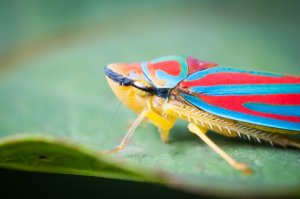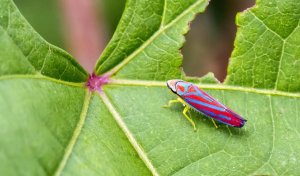Wild Wednesday: Candy-striped Leafhopper
October 19, 2022 Theia Calidris, Interpreter
It’s a sunny day in the garden as I work my way around the flower beds and fight with the water hose as I water my plants. A splash of color catches my attention; I stop my fussing and adjust my glasses to see a small, brightly striped insect sitting in plain sight on the Privet shrub in front of me. His body is bright turquoise with red stripes and his body looks to be mostly his head. I crouch down to get a better look, and *poof*; he’s gone.
My garden’s guest was a Candy-Striped Leafhopper, an aptly named insect native to North America that relies on its powerful legs to propel itself forwards and away from danger. They possess a single pair of wings and the ability to fly but often sit with their hind legs flexed; ready to leap up to 40 times their body lengths when needed.

Leafhoppers are placed within the Hemiptera order, taxonomically. Members of this order share one main thing in common: a piercing-sucking mouthpart that does exactly that to their food. Candy-Striped Leafhoppers, or Graphocephela coccinea, feed on plant sap by inserting their mouthparts into leaves and stems and sucking the juices out. When excess sap combines with bodily wastes, it’s expelled from their backsides with a sometimes audible ‘pop’ that has left them with the additional moniker of ‘sharpshooter’.

Candy-Striped Leafhoppers lay eggs in leaves that later hatch into nymphs who will depend on a supply of new leaf growth to feed on. They undergo incomplete metamorphosis, a process that takes them through 5 molts on the way to maturity. While they can be found on a number of plant species in urban areas, grasslands, and woodlands, they particularly Blackberry plants and their related species.
Unfortunately for the reputation of our colorful friends here, Candy-Striped Leafhoppers and many other leafhoppers have been associated with the spread of the disease-causing bacterium Xylella fastidiosa. This bacteria is transferred to new plants by leafhoppers that feed on plant tissue and has been known to leaf scorching and poor fruit set in affected plants.
